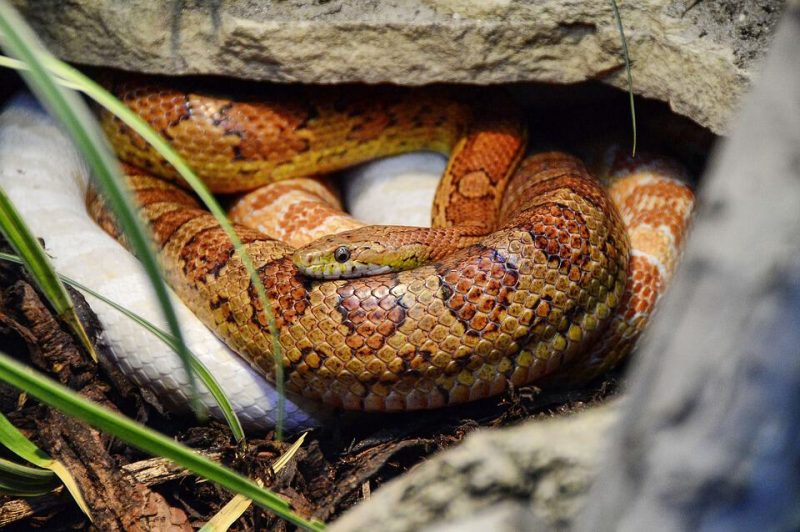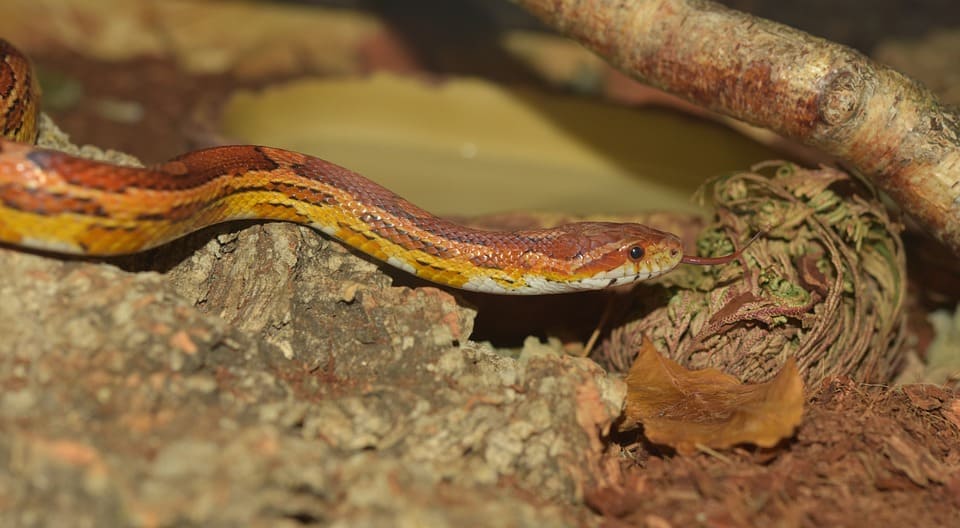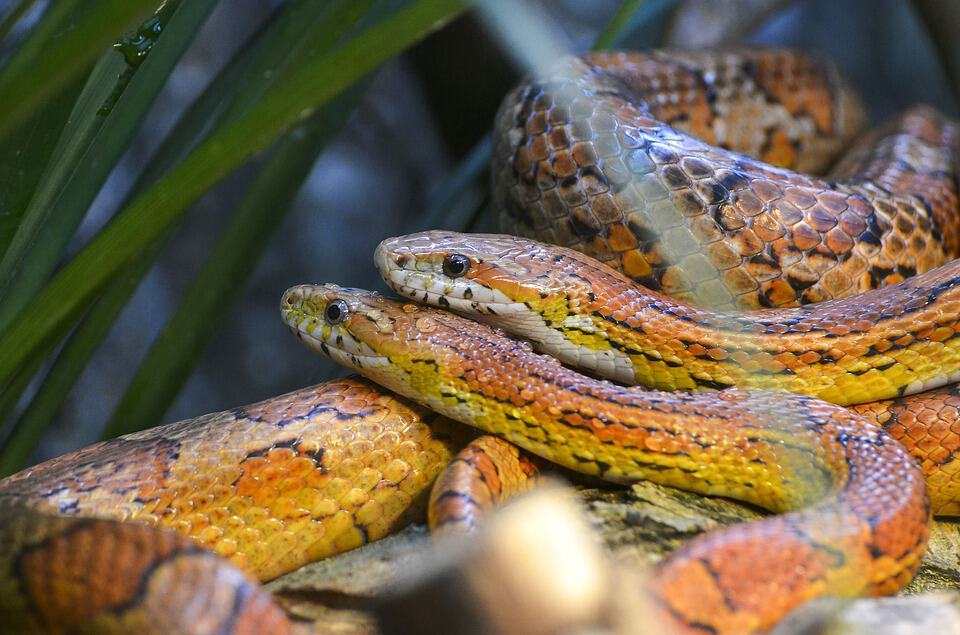Providing the proper habitat for your new pet corn snake is one of the most important things you’ll do as a keeper. Your snake’s habitat effectively becomes his entire world. Many of the health problems that afflict captive snakes can be traced back to improper habitat design and maintenance, so it is imperative that you acquire the proper enclosure and set in up in a sensible manner.
One of the neat things about corn snakes is their ability to thrive in either utilitarian or natural-looking habitats.
You can maintain your pet in a spartan, relatively “sterile” habitat, or you can decorate it so that it looks like a small version of the corn snake’s natural habitat. In fact, many keepers who’ve maintained public corn snake exhibits (including yours truly) have set up corn snake habitats that mimic the forests, wetlands and farms in which these snakes thrive.
Quick Navigation
Natural Habitat: Where Do Corn Snakes Live?
Wild corn snakes are primarily confined to the southeastern United States. Their range essentially covers the area stretching from Louisiana to North Carolina, and scattered pockets of corn snakes can be found as far north as New Jersey. Corn snakes are even found living in the Florida Keys.
Within this range, corn snakes inhabit several different types of habitats. Historically, corn snakes were likely most common in the hardwood, pine, and mixed forests of the southeast, and some individuals undoubtedly inhabited fields and wetlands too. Once humans began altering the North American landscape, corn snakes also began living in the farms they created.
Modern corn snakes inhabit the same types of forests, fields and wetlands they always have, and they’ve also managed to populate farms and other disturbed areas, ranging from backyards to gardens to vacant lots.
Corn Snake Tank Size
Corn snakes are relatively inactive snakes, who don’t need particularly large enclosures. Generally speaking, they require a habitat with a perimeter that measures twice their body length. In other words, a 2-foot-long young individual would require a habitat with a 4-foot perimeter. Similarly, a 6-foot-long adult would require a habitat with a 12-foot perimeter.
However, these should represent the minimal requirements – you can always provide your snake with a larger habitat if you like. Some advanced keepers report that large habitats can make snakes feel insecure, but this is simply incorrect. It is true that large empty habitats may make snakes feel nervous or exposed, but they’ll feel completely at ease in complex habitats with plenty of visual barriers and hiding spaces.
Corn snakes don’t necessarily need habitats that provide a great deal of vertical height, but because they are avid climbers, it is often helpful to do so.
>Further Reading: Corn Snake Care Sheet: A Simple (But Complete) Guide for Beginners
Heating and Temperature Range for Your Corn Snake Enclosure
Corn snakes are ectothermic animals, whose body temperature fluctuates with the ambient temperatures. This means that you must manage the temperatures in your pet’s habitat carefully.
The best way to do so is by establishing a thermal gradient. This means that the habitat should provide your snake with a range of temperatures – this way your snake can move around the habitat to adjust his body temperature.
Creating a thermal gradient is pretty easy; you simply need to place the heating device at one end of the enclosure. The spot closest to the heating device becomes the basking spot, while the far side of the habitat will then serve as a cool retreat, which your snake can use when he needs to cool off.
Heat lamps are typically the best heating devices for beginners, but you can also use heat pads, heat tape or radiant heat panels. Just be sure that you invest in a good digital thermometer so that you can monitor the temperatures carefully. Place the thermometer at one end of the enclosure and position the remote probe (if present) at the opposite side of the habitat.
Shoot for a basking spot temperature of about 90 degrees Fahrenheit. The temperature should fall with increasing distance from the basking spot, with the cool side of the habitat remaining in the low- to mid-70s. It isn’t always possible to achieve such a drastic gradient in small habitats, but this should be your goal.
It is generally wise to turn the heating devices off at night, to mimic the temperature drop that occurs outdoors. Just be sure that your pet’s habitat doesn’t drop below the mid- to high-60s. If it does, you’ll need to add a nocturnal, light-free heating device to the habitat to prevent your pet from falling ill.
Suitable Humidity in a Corn Snake Terrarium
Temperature isn’t the only thing you need to monitor for your pet corn snake – you must also monitor the humidity level in the habitat. Fortunately, corn snakes will tolerate a fairly wide range of humidity levels, unlike some other snakes, which have fairly specific humidity requirements.
As a ball-park figure, shoot for a humidity level in the 50% to 70% range. If you keep the habitat much drier than this, your snake will likely have trouble shedding properly; keep it wetter than this, and your snake may develop bacterial and fungal infections.
There are several ways to raise the humidity level of your corn snake’s habitat (because of the presence of the heat lamp, it’ll rarely be necessary to reduce the habitat humidity in practice). You can use a moisture-retaining substrate and dampen it periodically, or you can simply provide a larger water dish. You can also mist the habitat regularly or reduce the amount of ventilation (carefully) to increase the relative humidity.
Another approach that is often helpful is to provide your snake with a moist retreat. This is essentially a hide box that’s kept slightly damp by keeping a layer of moistened moss or wood chips inside. This gives the snake a chance to rest in a high-humidity environment when necessary, without forcing them to remain in a damp habitat at all times.
What Is the Best Corn Snake Bedding?
There are a variety of different beddings you can use for your snake’s habitat. Some of the best include:
- Newspaper or Paper Towels – Newspaper and paper towels are excellent substrates for beginners and any other keeper who likes to keep things simple. Not only are these substrates free (or nearly so), they make it very easy to keep the habitat clean. Contrary to what some new keepers think, your snake probably doesn’t care whether or not his habitat looks “natural.” As long as their needs are met, they’re typically “happy” with simple substrates like these. Just be sure that you change the newspaper or paper towels when they become soiled.
- Aspen Shavings – Aspen mulch is one of the most popular choices among professional corn snake breeders (although many opt to use newspaper instead). Aspen is safe for corn snakes, it is relatively affordable, and it smells quite nice. You can also “spot clean” aspen shavings, instead of having to change the entire substrate such as you would when using newspaper. Just be sure that you keep the shavings pretty dry, as aspen will rot when allowed to remain wet.
- Cypress Mulch – Cypress mulch is an acceptable substrate for corn snakes that some keepers (including the author) prefer above most others. Cypress mulch maintains moisture well, it lasts for a long time, and it is easy to spot clean. It’s also affordable (although this varies with your location), and it looks great.
- Orchid Bark – In a perfect world, most keepers would probably use orchid bark as a substrate for most snakes. It is attractive, it smells pleasant, it lasts for a very long time, and it’s too large for most snakes to accidentally swallow. The primary drawback to orchid bark is its price – orchid bark is quite expensive.
>Further Reading: What Do Corn Snakes Eat? A Diet & Food Guide
Corn Snake Supplies and Accessories
We’ve discussed most of the things you’ll need for your corn snake’s habitat in the preceding sections, but we’ll run them down one more time to make it easier for you to pick up everything you need.
- Enclosure
- Heat lamp and bulb
- Digital thermometer
- Water dish
- Hide box (at least one, but multiple hide boxes are ideal)
- Climbing branches
- Substrate
Remember: A Proper Corn Snake Habitat Is Critical for Success
Your corn snake’s habitat becomes his world, so make sure that you do everything possible to provide him with the best enclosure you can. Just heed the advice presented above and be sure to think about things from your snake’s point of view. This will help ensure your snake enjoys the enclosure and give him the best chance of living a long, healthy life.











52 Comments
Hey i love your article and i just have a question. There might be a chance i can get a corn snake but i don´t know if i would get live or frozen food for them and if they specifically need mice or rats( i would think mice because of their size) thank you
– sofia
Hi Sofia! I’m glad you found the article helpful. Corn snakes can eat both live and frozen/thawed prey, but feeding frozen/thawed prey is generally considered safer for the snake and more convenient for the owner. Live prey can potentially harm the snake by biting or scratching it. Frozen/thawed prey can be purchased in bulk and stored in the freezer until needed.
As for the type of prey, corn snakes can eat mice or rats depending on their size. Young corn snakes will start with pinky mice and gradually move up in size as they grow. Adult corn snakes can eat adult mice or small rats. It’s important to feed your corn snake appropriately sized prey that is no larger than 1.5 times the widest part of its body.
I hope this helps! Let me know if you have any other questions.
Looking into getting a corn snake. Are they typically sold only as babies? Or can you opt for a 1-2 year old. What is your recommendation for a first timer?
Also, regarding terrariums, I’d like to set up a nice one and done 70-80 gallon. If stocked with plenty of foliage/branches/hides, is this size too overwhelming for a baby?
Hi Steve!
Corn snakes are typically sold as babies and hatchlings, but some breeders may offer older snakes if you ask. My recommendation for a first-timer is to get a baby or hatchling, as they will be easier to handle and acclimate to their new environment.
A 70-80 gallon terrarium is likely too big for a baby corn snake, but if it’s stocked with plenty of foliage, branches and hides then it should still provide the necessary cover and hiding spots for your snake. I would recommend starting out with a smaller terrarium and then upgrading to a larger one as your snake grows.
I hope this answers your questions, but if you have any other inquiries feel free to reach out!
Good luck with your corn snake! 🙂
Hi Ben!
Next month my corn snake will be arriving and I’m doing everything possible to make sure I’m ready to receive him and he will be comfortable.
One thing I’ve learned is that snakes prefer close spaces over open spaces and the advise is to block off 3 sides of the tank to make sure the snake is less stressed and will eat and move around a bit more.
I’m looking into backgrounds for my tank… does the image on the background matter for the snake’s stress? Will it affect the snake negatively if the background is of an open space like the forrest?
Hi Jenny
No, the image on the background should not affect your corn snake’s stress. In fact, it’s best to keep the background as natural-looking as possible because snakes are most comfortable in their natural habitats.
If you choose a forest scene or something similar, make sure it is realistic and not too bright or busy. That way, your snake will feel comfortable and at ease in his new enclosure. Try to find a background that is not too overwhelming or distracting for your snake.
If you want, you can also add some foliage or artificial plants to make the environment even more natural-looking and inviting.
I hope this helps! Good luck with your new pet!
Hi, I am in 8th grade, and me and my class are getting a class pet. I was wondering if a corn snake would be a good option. Also would it be ok for it to be alone during the weekends, or if there is anything else I should know before sugjesting we get one? If not, are there any other snake breeds that we could get that you know of?
Also found this website verry helpful and informative thanks. : )
Hi,
A corn snake can be a good option for your classroom pet. They are usually very easy to care for and handle, so they can make great pets for all ages.
Corn snakes also tend to do well when left alone as long as you keep their habitat clean and provide them with enough food and water.
In addition, you could also consider a king snake or Ball python if you want to explore other breeds. Both of these snakes can make good pets as well and require similar care as corn snakes. Whichever type of snake you decide on, make sure that you do your research, so you are prepared for the responsibility!
Good luck with your decision.
Hello! I hope you’re having a great day. I’m trying to convince my parents to let me get a corn snake, and I’ve done a lot of research. This website has helped a lot, but my question is about the newspaper substrate. Do you just lay it flat, or do you tear it up. And if you tear it up, does the shape/size matter? If you lay it flat, how many layers would you need?
Thanks!
Hi Cloud!
I’m glad you’ve been researching corn snakes and the best way to care for them. When it comes to newspaper substrate, you will want to tear it into small pieces or strips – the size of each piece doesn’t really matter as long as they’re not too big. If you lay it flat, then make sure there are at least 2-3 layers so the snake feels secure.
I hope this helps! Please let me know if you have any other questions about caring for your corn snake. Best of luck!
I was wondering if theres a recommended place to put my corn snake im doing research now because i am getting one next Month i was planning on putting my snake in the corner of my room but i also have led lights in my room will that effect the snake? How do i know if my room is to hot or cold for my snake? How do i also keep their tank moist enough? Im sorry for so many questions i just want to make sure i can give them the best home.
Hey Brooke, I’m glad you’re doing your research ahead of time! I have answered your question below.
1. A good place for your corn snake tank would be in the corner of your room, near a window. You should make sure the temperature in the room is comfortable for your snake – not too hot or cold.
2. LED lights should not affect your corn snake, as they do not produce much heat. However, if you have LED lights on for long periods of time, it may make the room too bright for your corn snake to feel comfortable. If you notice your corn snake avoiding the light, try dimming the lights or turning them off for a while.
3. If your corn snake is basking in an area that’s too hot, it will move away from the heat source and seek a cooler spot. If the room temperature is too cold, your corn snake may become sluggish and have trouble digesting its food. The optimal temperature range for corn snakes is 75-82°F on the cool side and 80-85°F on the warm side. By monitoring your corn snake’s behavior, you can make sure it’s comfortable and healthy.
4. You can keep the tank moist enough by misting it with water regularly.
Good luck!
I was wondering I had a 10gal tank setup for a Leopard Geko years back & still have everything for it . My question is could I use it for a starter Corn Snake setup ? it has a heater under the tank but wouldn’t have to plug it in.
Hi Chester,
You will need to make some adaptations but you could potentially use your old gecko vivarium to begin with. The heat mat will need to be on the back of the tank, not underneath and it should not cover the entire length and you will need to have a warm end and cold end. Make sure you don’t use ceramic heaters with corn snakes as this can cause burns. Provide plenty of hiding space, the correct substrate and water bowl.
Hi, thank you so much. I have bought my first corn snake and tank. The tank setup came with a heat pad, a thermometer etc. I am not too sure if I have understood what you have said about the temperature. Do I put the probe for the heat pad and the thermometer together on top of the heat pad so I know it is at the right temp or on the other side of the tank so I know how warm the cool area is? Sorry
Hey Steve!
It is very dependent on the heat source you are using. You should have the probe right on top of the heat mat if you’re utilizing a heat mat that your snake coils up onto.
I recommend having two thermometers one for the warmest sections in the vivarium and the other for the cool area. However, if you have only one it is best to place your thermometer in the warmer area because the cooler area will likely have the same temperature as the rest of the room.
Good Luck!
Hi. I’m 12 and am thinking about getting a corn snake. I wanted to know if there was a certain place that was better than another to by my snake.
Hi Ryan,
I would do a google search for exotic pet shops in your area and see which ones have the best ratings. Also check on the local forums and see which shops people are recommending.
I see that you recommend a heat lamp. Can we just do the heat mat on one side of the tank and no lamp?
Second question. My son is asking for a corn snake for Christmas he has done his research and says he’ll
Provide the snakes care. Realistically can a 11 year old provide most of the care and cleaning for the snake or is this animal
not a good choice in that regard?
Hi Laura,
This really depends on the temperature inside your house and where you live. If the heat mat alone keeps the vivarium at the correct temperature then you may not need a heat lamp. Make sure your heat mat is connected to a thermostat. Corn snakes make a great first snake and their care is relatively simple, with parental supervision a smart 11 year old should be able to provide basic care but it would be best if you could assist and monitor the animal for any signs of illness. I do not recommend buying animals for christmas as these snakes can live for over 25 years, so first make sure this is what he really wants before proceeding.
Do albino/snow corns need more specialized temps or humidity because of their albinism? Or any other special aspects of their habitat?
Hi Ruby,
Albino/Snow Corn Snakes are still pretty hardy and do not necessarily require any extra care. However, it is recommended to provide them with a moist hide to assist them with shedding.
Hi i was wondering if i needed a heat pad? I would be getting a heat lamp but im not sure about the heat pad. Heat pads and thermostats are a little pricey so if they arent needed , i wouldnt buy it. Ofcourse , the snake’s happiness comes first still so , i would like to hear about your opinion.
Hi Adrian,
It really depends on where you live and the temperature of the room you keep the snake in at night and during the day. The heat lamp may be enough on its own if your temperatures are correct in the day and not dropping too low at night.
Hello!
Loved your article, it was very helpful!
Im looking into getting my first snake and i was wondering how to know/keep track of the humidity in the tank. Is a simple water bowl enough for the humidity level, if not, what is a cheap way to keep it humid? Also, what would be the ideal bedding if i want to plant plants, and how would i clean it without disrupting the plants? How could i install climbing branches? Does the corn snake need a UVB light?
Sorry for all the questions!
Thanks,
Irene
Hi Irene,
I’m glad you liked Ben’s article. There are lots of hygrometers (humidity gauges) on the market for reptile enclosures, some big brands are Zoo Med or Exo Terra. Corn snakes require a relatively low level of humidity (40-50%), a water bowl at the cool end of the tank is usually adequate, make sure the tank is adequately ventilated. Plants are likely to make the humidity too high in a corn snake enclosure, so I would opt for fake plants instead. You can find sandblasted branches and vines at pet shops or online, these can be jammed in place or cable tied to the vents at the top of the tank. As juveniles corn snakes do not require a UVA/UVB light but a 2% light is recommended for them once they are grown and placed into a proper vivarium.
Ben,
I have a corn snake but it’s pretty young and I only got her recently and I’m wondering how can I tell it’s gender? Is there some sort of method?
Hi Zayba,
The best way to tell the sex of a corn snake is by probing. He/She will need to be probed by a professional with experience as if this is done incorrectly the snake could be seriously hurt.
Hi there, we have am 18 month old cornsnake that we are getting ready to upgrade the habitat of. We want to include some real planting for decoration and something for climbing. Is there anything in particular you recommend?
Hi Karen,
I usually recommend plastic plants for corn snake enclosures as they require a relatively low humidity level of 40% – 50%, plants also make cleaning enclosures more difficult. However, if you would still like to add some live plants, I would suggest species that require relatively low amounts of water like air-plants, string of pearl plants (Senecio citriformis) and various species of fern. When it comes to things for them to climb on, I find sandblasted grape vine is best.
Your opening picture suggests multiple corn snakes in a single tank, is that really a good idea? Wouldn’t they fight or worse? I only ask because I have a corn and I’m not sure as to whether it is male or female “thank you surplus pet store” and I feel horrible sexing them because if not done right it could hurt them and my corn is still quite young. This is my third corn and I love them as they are so easy to care for and such wonderful pets, I’ve never been struck by any of my corns. But, back to the original comment, housing more than one in a single tank? Possible?? If so yay and how??? I’d love more my slithery friends.
Hey, Angela.
That is just a stock photo. 😊 Some keepers do keep corn snakes together, while others keep them singly.
Typically, I discourage beginners from keeping more than one snake in a habitat. However, I have kept numerous corn snakes together in the same enclosure without issue – they typically get along fine. It is, however, usually advisable to avoid housing mature males together.
Also, keep in mind that if you purchase another snake, you’ll need to have access to a separate enclosure in case the two don’t cohabitate peacefully.
Long story short: You can try keeping corn snakes together but be ready to intervene and separate the two if they don’t get along. And understand that “not getting along” may involve biting, which means you’ll have to put your hands in the middle of a couple of irritated snakes.
It’s probably best to just house your corn snakes individually.
Best of luck!
Hey I’m 13 and I’m thinking of getting a corn snake but I want to make sure I’ve done my research first as it is my first. I was wondering how warm my room would have to be on average or would the heat lamp keep it warm? I also have a really small room and only 1 window so would that be enough natural light or not? It would really be appreciated if you could help xx
Hey, Gabby.
Kudos on doing your research first!
The lighting won’t be an issue, but the only way you’ll know about the temperatures is to set up the enclosure, monitor the temperatures with a thermometer, and make any changes necessary.
But in most cases (unless your house is unusually cold), you should be able to keep the habitat warm enough with a heat lamp.
Best of luck!
I am about to get a corn snake and I had a question. What do you feed them???
Hi Tiyek, This guide will help you!
Hello,
Today I brought home my first corn snake. I have a question about humidity. Why do sources online vary so much? I’ve seen 35-50, 40-50, 40-60, 50-60, 65-75. I’d love to take your great article at face value but I’m having trouble with all the contradicting sources, what do you think?
Hey there, Qozeem.
The more you read about reptile care, the more you’ll notice that maintenance advice varies wildly from one author to the next. This is especially true of humidity. Fortunately for your case, corn snakes aren’t terribly sensitive to humidity levels. Just make sure the enclosure isn’t dripping wet nor bone dry, and your corn snake will remain healthy while you dial in the perfect humidity level.
I would, however, recommend that you err on the dry side, unless your snake exhibits poor sheds. As long as your corn snake has access to water, he or she should be able to tolerate slightly dry conditions without suffering serious harm. You can also keep a damp hide in the enclosure, which will give him or her a more humid place to hang out.
But if you notice rough sheds, bump up the humidity level slightly.
Best of luck!
Ben,
Wonderful article. Thank you. I’ll be acquiring a corn snake soon, which will be my first snake; so, I’m new to all of this. I have a few question about lighting. Does a corn snake enclosure require overhead lighting? I’m not talking about as a heat source (I would use a pad or heat lamp). Rather, I’m curious about lighting just to light the enclosure. Is the ambient room light sufficient for a corn? Does it prefer to have direct overhead lighting to mimic the white light from the sun? Is there such a thing as “moon lighting” to mimic the outdoors during a full moon, for example?
Thanks,
Sean
Thanks for the kind words, Sean! Glad you enjoyed the article (and I appreciate your use of semicolons — lol).
No – your corn snake does not require any supplemental lighting. The ambient light in the room will be more than sufficient. However, you can install lighting if you’d like, and it will likely make him more attractive (just be sure to measure your temperatures – even fluorescent lights produce some heat).
There are some “moon lights” on the market, which you could use to illuminate the habitat slightly at night. I doubt your snake will care, but it shouldn’t cause any problems if you’d like to include one.
Best of luck with your new pet!
Hi,
We have a rescue snake. Honesty, I think we rushed our decision to adopt him but there you go.
He has suddenly stopped eating and then when we do tempt him he regurgitates the mouse! He has not eaten for 4 weeks now. He escaped from his tank the other day and was on the run for 2 days.
Was he looking for better food?
What do we do? (Can you tell I am slightly panicked)
Hi Niki,
No need to panic! It is possible that the snake was looking for better food, or a more comfortable environment. The first step is to ensure the tank has all of the proper environmental conditions your pet needs, such as proper temperature, humidity, and substrate.
If these are not optimal then this could be causing him distress and leading to his lack of appetite. If these factors are ok, then there could be other underlying medical issues.
I would recommend taking the snake to an experienced reptile vet for a full examination and diagnostic tests, such as bloodwork and fecal analysis, to rule out any more serious problems like parasites or infections.
In the meantime, you can try offering him smaller and more palatable food items such as small pinky mice or canned insect larvae.
I hope this helps! Good luck.
Can I provide a small pond like a bowl with water filer for the corn snake?
Hey, Mark.
You can, but you’ll still need to remove the dish and wash it regularly, so it’ll end up being a TON of work.
I’d recommend just keeping things simple – especially if this is your first snake.
Best of luck!
Hi Ben,
Article was great thanks for educating people on how to care for a corn snake! I am upgrading my cornsnake in closure and was wondering if I could use a mixture of peat moss (roasted to kill any possible bugs inside) and aspen shavings as a substrate?
Hi Ada,
As long as the peat moss hasn’t been fertilized, sprayed with pesticides or herbicides, or bathed in chemicals, using a mix of peat moss and aspen shavings as a substrate for your corn snake is safe.
Good Luck!